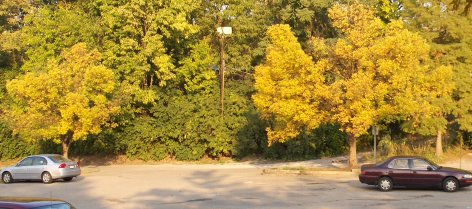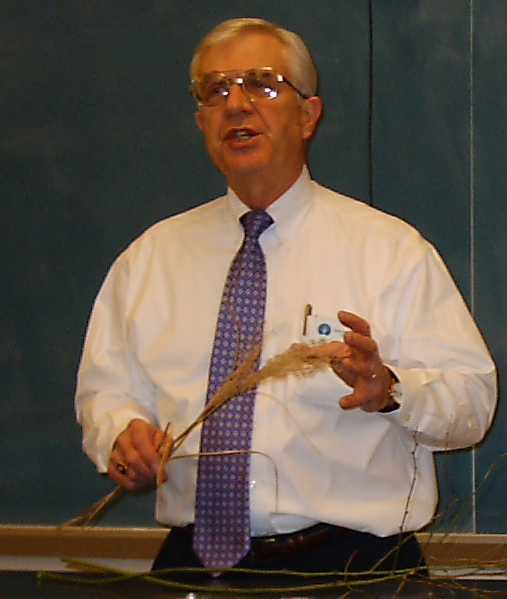Plants to Remember for Next Week
| Ulmus sp. |
American, Red, ect. (does he
mean etc.?) |
| Ulmus parvifolia |
Chinese Elm |
| Cladrastis kentukea |
Yellowwood |
| Morus alba |
Mulberry |
| Taxodium distichum |
Bald Cypress |
| Metasequoia glyptostroboides |
Dawn Redwood |
| Catalpa speciosa |
Catalpa |
| Sassafras albidum |
Sassafras |
| Cercis canadensis |
Redbud |
| Crataegus phaenopyrum |
Washington Hawthorn |
| Crataegu viridis 'Winter King' |
Winter King Hawthorn |
| Koelreuteria paniculata |
Goldenraintree |
Thornless Honeylocust, Gleditsia tricanthos var. inermis
Characteristics:
- medium-large
- full sun
- OK with water
- yellow fall color
- drop early
- small leaves
- thornless
- not seedless
- never know when they will fruit
- Leaves are pinnately compound. Some are bi-pinnately compound.
- Fairly coarse stem.
- borers
- cankering
- Honey Locust Bug (TODO: this is not the full name of the bug. Find the full name) can defoliate tree.
Gleditsia tricanthos var. inermis, Thornless Honeylocust, from a distance.
A closer look at Gleditia tricanthos var. inermis, Thornless Honeylocust.
The bark of Geliditsi tricanthos var. inermis, Thornless Honeylocust
As a bonus, a person in the background walking away from a mid-90's Dodge Neon.
A cutting of Gleditsia tricanthos var. inermis, Thornless Honeylocust
Fraxinus pennsylvanica, Green Ash
Characteristics:
- Yellow fall color.
- Fuzzy, plump bud.
- Large - 50-60'.
- Most cultivars are seedless.
- Pinnately compound leaf.
- Similar to Kentucky Coffeetree, but Kentucky Coffeetree has salmon-colored inside.
- Emerald Ash Borer, takes one year to kill a tree. Must cut all Ash Trees within 1/2 mile radius.

Fraxinus pennsylvanica, Green Ash, from a distance.
Fraxinus pennsylvanica, Green Ash
Fraxinus pennsylvanica, close
Bud of the Fraxinus pennsylvanica
Fraxinus americana, White Ash
Characteristics:
- Purple fall color.
- On young trees only - smooth bark.
- Leaf removal leaves smiley face with bud in it.
Fraxinus americana, White Ash, from a distance
Fraxinus americana, White Ash
Bark of the adult Fraxinus americana, White Ash
My Fraxinus americana cutting. And my feet.
Note the gall on the stem.
Platanus x acerifolia, London Planetree
Characteristics:
- Large, 60-70'
- Similar to Sycamore, but Sycamores are more prone to Antrhacnose.
- London Planetree is a hybrid of the Native Sycamore and Oriental species. This hybrid is resistant to Antracnose.
- LPT is a green, patchy-barked tree, often planted. The Sycamore is a white-barked tree, most often found in the wild.
- The Sycamore curls, whil the LPT does not curl as much.
- LPT tolerates flood plain, heavy clay.
- Bloodgood is a common LPT cultivar.
- Very tough tree.
- Can withstand urban landscape.
- See lots of these at the Serpentine Wall, on the Ohio River, near downtown.
- Puffball-looking fruit.
- Leaf looks like maple. But, LPT is alternate, while Maple is opposite.
- The bud is enclosed by the petiole.
- Olive green stem.
Platanus x acerifolia - a big tree.
Characteristic bark of the Platanus x acerifolia
Fruit of Platanus x acerifolia, London Planetree
My cutting of the Platanus x acerifolia
Cornus florida, Flowering Dogwood
Characteristics
- White flowers mid-April.
- Native
- Burgundy fall color
- Fruit - red berries in a cluster. Each fruit has a single seed.
- Plant on North or East side.
- Protect from afternoon sun.
- Small tree.
- Borer
- Powdery Mildew
- Plant in good soil.
- Keep watered.
- Keep out of afternoon sun.
- The Cornus kousa has a silky brown bud. Cornus florida has
green buds.
Cornus florida, Flowering Dogwood
Closeup of Cornus florida, Flowering Dogwood
My Cornus florida, Flowering Dogwood, cutting
Fruit of the Cornus florida, Flowering Dogwood
Cercis canadensis, Redbud
Characteristics
- Small trees, dogwood size. (TODO: verify this. The tree appears
much larger in this picture than a Dogwood.)
- Love shade and sun - can take anything.
- Flower in the Spring.
- Tend to be subject to wilt after 15-20 years.
- Short lived, but easy to grow.
- Boom on last year's wood.
- Early April bloomers.
- Dogwood/Redbud combination is popular.
- Heart shaped leaves.
- Alternate leaves.
- Yellow fall color.
- Wilt
- White flowers
- Wheeping
- Lavendar twist
- Red Leaved form
Cercis canadensis, Redbud
Cercis canadensis Redbud cuttng
Nyssa sylvatica, Black Gum, Tupelo
Characteristics
- Fall color: fire engine red.
- Nondescript leaf.
- Identify by 3 dots near the leaf - I am going to try to get a better picture of this.
- Leaves can get twice as large as our sample, and shiny, when older.
- Need to verify the size of the tree - I have 'large' in my notes, but also a comment to verify that it is a large tree.
- See these in Clermont County.
- Straight trunk, 90 degree angle branches.
Nyssa sylvatica Black Gum Tupelo fall leaf color
Amelanchier x grandiflora, Apple Serviceberry
Three Versions:
- Cumulus - tree form.
- Apple Serviceberry - has about 15 branches.
- Shrub - has about 50 branches.
- Gren buds, red color.
- Long and pointy buds.
- Serrated leaves.
- Alternate leaves.
- Orange and red fall color.
- Also called Juneberry.
- Blueberry-like edible fruit.
- Birds eat them.
- Waxy coating over part of stem.
- Lots of stems, especially on shrubs.
- Exgrandiflora -best fall color.
Amelanchier grandiflora, Apple Serviceberry, outsize the Cincinnati Zoo's new educational center.
Ameanchier x grandiflora, Apple Serviceberry, cutting
Bonus - Cumulus, The Tree
cumulus (TODO: verify that this is the correct Genus/species name)
cumulus vs. grandiflora Comparison
Unfortunately, I did not note which was which, because I was too busy taking the picture. You can probably figure it out by looking at other pictures on this page, though.
Cornus mas, Cornelian Cherry Dogwood
Characteristics
- Large shrub.
- Buds at leaf axles.
- Yellow flower in buds - sulfur yellow.
- 15' range.
- Can be pruned smaller.
- Not much fall color - green, red, burgundy.
- March bloom, around for Forsythia (early).
- Sublte.
- Green stem.
- Tough plants, but scorch easily.
- Fruit - red berries, one each axle.
- Edible, juicable.
- The Cornus kousa / Kousa Dogwood does not have buds on the axles.
Cornus mas, Cornelian Cherry Dogwood
Cornus mas, Cornelian Cherrry Dogwood
Cornus mas, Cornelian Cherry Dogwoood cutting.
Cornus kousa, Kousa Dogwood
Characteristics
- Blooms after foliage, about three weeks later than Cornus florida, flowering dogwood.
- Blooms on top - good for a looking down effect.
- Bloom is a creamy yellow, fades to white.
- Fruits in the late summer, looks like a little strawberry.
- Mushy fruit is edible.
- Burgundy, orange, yellow fall color.
- Prune high, not severe.
- Can tolerate shade.
- Likes afternoon shade.
- Likes good soil.
- The Cornus kousa / Kousa Dogwood does not have buds on the axles.
Rutgers hybrid is Florida x kousa.
Milky Way is a good cultivar.
Cornus kousa, Kousa Dogwood
Bark of the Cornus kousa, Kousa Dogwood
Cornus kousa, Kousa Dogwood cutting
Bonus
- Spring Grove Dogwood
Spring Grove Dogwood

And it's a WONDERFUL plant!